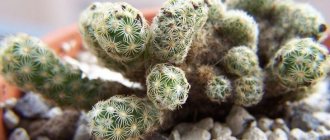Mammillaria have long conquered the hearts of cactus lovers; they are very popular due to their extremely unusual shape, amazing colors and even types of needles. They are completely unpretentious and anyone can cope with them - the prickly creatures forgive their owner’s mistakes and mistakes in maintenance. Many connoisseurs of house plants prefer mammillaria; small prickly “balls” captivate with their neat, miniature appearance, and during flowering they enchant with their amazingly delicate buds.
Description of the plant
Mammillaria cactus is one of the most numerous genera in the Cactaceae family.
It was first mentioned in the scientific work of the Swedish scientist Carl Linnaeus in 1753 “Species of Plants” under the name Cactus mammillaris. Translated from Latin, mammilla means tubercle or nipple. One of the characteristic features of the structure of a cactus is the presence of tubercles or tubercles (papillae). Mammillaria is not a large, but rather a miniature plant. The stem is small, fleshy, spherical, short cylindrical, flattened, 1–20 cm in diameter and 1–40 cm in height. Stems are solitary or branched. It is covered with tubercles-papillae, which are, in fact, some kind of leaves, and at the end of each tubercle there is an areola. The areola is a modified axillary bud, on the top of which there is a tuft of hairs and spines.
Mammillaria does not have ribs, like other members of the family. Over the entire surface of the stem, tightly or not tightly pressed to each other, tubercles or papillae of various shapes are located randomly or in a spiral.
Flowers and side shoots develop in the axils of the tubercles. In the upper part of the stem, tubercles have sharp, hard spines, and in the lower part they are covered with down or hairs. In the place on the stem where the flower bud begins to form, the amount of fluff or villi increases.
The roots are shallow, thickened, fleshy, dense, tenacious.
Mammillaria blooms in early spring; small, delicate flowers form one at a time or in a group in the axils between the tubercles. In most species, the flowers form a ring at the top of the stem.
The shape of flower corollas is:
- campanulate;
- tubular;
- disc-shaped.
Flower diameter varies from 1 to 6 cm, petal length from 4 to 30 mm, width from 1.5 to 9 mm, depending on the species. The colors are white, yellowish, silver, beige, pink or red. Sunlight is required for the flower to fully open.
Pollination occurs with the help of insects or the wind (self-pollination). The ovary is formed after flowering in the axils of the papillae and is tiny in size. The fruits are bright, round or club-shaped, 1–3 cm long, and ripen in 2–3 months. During the growth process, the fruits increase in size and become visible on the surface of the plant in the form of a growth.
The fruits serve as an additional decoration for the cactus; they remain on the stem for about 6–10 months. Ripe seed pods crack, scattering seeds onto the ground. Each growth berry contains small seeds of brown, red or green color.
Mammillaria are capable of germinating singly and also forming large groups due to lateral shoots.
The plant is drought-resistant, tolerates moisture deficiency and its complete absence. The natural habitat of cacti is quite wide; mammillaria cacti can be found in Mexico, the southwestern United States, Honduras, Colombia, Venezuela, and Guatemala. It can be seen near the sea coast and on the limestone hills up to 2.5 km away.
Bloom
Mammillaria cacti bloom from spring to autumn. At home, flowering can occur even in winter; during this period it is necessary to create additional lighting for the cactus. On average, the daylight hours for a plant should be at least 16 hours. If necessary, use special lamps. Mammillaria can bloom for about 6 months.
In most species, the flowers are located at the top of the central stem in the form of a crown. The colors of the buds are very diverse: white, red, scarlet, crimson, beige, cream, pale yellow. Some species have large flowers 3–5 cm in diameter; in this case, the cactus produces only 1–3 such flowers.
Difficulties in growing
When growing mammillaria cactus at home, a gardener may encounter the following difficulties:
- the plant is not afraid of a lack of moisture, but its excess can cause unpleasant consequences;
- improper lighting will lead to loss of decorative properties, the stem will stretch.
It is also worth remembering that poor growth can be a consequence of lack of rest in winter, irrigation with cold water, frequent changes from one place to another, or lack of replanting.
Do not forget that a cactus, like any other living organism, can suffer from diseases and pest attacks. The following two species are considered the most dangerous parasites for mammillaria.
- Red spider mite. Its presence can be noticed by rusty spots and a dehydrated surface that is unable to recover. Control of this insect involves repeated treatment with insecticides over several weeks.
- Cactus scale can infect a plant and cause irreversible consequences. To eliminate the pest, it is worth treating with a high-quality insecticide.
Mammillaria often suffers from late blight and spotting. To avoid infection with these diseases, regular preventive treatment with fungicides should be carried out. This type of indoor flower is also susceptible to rot. If a problem is detected, the gardener must immediately remove the affected fragment of the plant: this action will protect the cactus from the spread of infection and preserve its health.
Types and varieties
All representatives of the species, of which there are more than two hundred, have decorative value, many have gained wide popularity in indoor culture. Currently, new varieties are being found, and the species of mammillaria is being replenished. All kinds of mammillaria are among the most popular thorny plants for collecting.
Mammillaria cacti are convenient for beginning gardeners due to their unpretentiousness and survive even with the most severe violation of conditions. This feature did not go unnoticed - they became extremely popular.
Many cacti look like fluffy balls of wool (Mammillaria gana, Mammillaria plumosa), others are highly decorative (Mammillaria runner), but all of them are united by the amazingly beautiful delicate flowers of spiny creatures, unusual shapes and sizes. It's no surprise that most plant lovers choose mammillaria to decorate their homes.
Golden-haired
Golden-haired
The species is native to the hilly highlands of Mexico. A single dark green stem is 4–6 cm tall, has the shape of a slightly flattened ball with a diameter of up to 6–8 cm. The root is thick, fleshy, dense. The tubercles are elongated, oval, do not touch each other, and are located quite rarely. There are no thorns as such; the cactus is covered with hair-like thin, white needles and threads.
It blooms with large bell-shaped flowers up to 3 cm in diameter, the petals are beige or cream with a pink longitudinal stripe on each petal.
Bokasana
Bokasana
A species with a dense, cylindrical stem up to 4–6 cm in height, dark green in color. The spines are long, dark, with hooks at the ends; they are framed by a tuft of long white hair. During the flowering period, Mammillaria bocasana is overgrown with a wreath of pale pink bell-shaped flowers.
With good care it pleases with annual flowering.
Wilda
Wilda
The barrel-shaped stem is dark green, up to 3–5 cm in diameter. The tubercles are short, elongated. The central hook-shaped hard spine is framed by thin, thread-like spines. Mammillaria wilda often produces numerous lateral shoots of “babies” up to 2 cm long, which continue to grow and develop on the mother trunk and do not fall off on their own.
It often blooms with small white flowers with a bright yellow core; fruits and berries are formed after pollination.
Bokasanskaya
Bokasanskaya
The stem is thick, oblong, 4–5 cm in diameter, the tubercles are oval, elongated. Mammillaria bocasan produces many babies, forming large groups. From the rosette, at the top of the tubercles, grows a hard dark hook-shaped spine, framed by light hair-like spines.
During the flowering period, the cactus is covered with many white small buds; the seeds and berries appear only after cross-pollination.
Zeilman
Zeilman
A beautifully flowering species with a charming wreath of small bright pink flowers (sometimes white). Seilman's mammillaria can bloom for six months. The stem is round or short cylindrical with densely set papillae. The central spike with a hook is surrounded by a bunch of white thin spines.
Runaway
Runaway
The miniature species forms a large group due to the many side shoots. The stems are small and round. The spines are hair-like, needle-shaped, golden in the center of the rosette, white at the edges, densely covering the stem.
Mammillaria runnerum blooms with white flowers; bright red fruits and berries are formed without cross-pollination on the surface of the stem and serve as an additional decoration for the cactus.
Carmen
Carmen
The highly branching cactus quickly forms groups. The stem is dense, elongated, oval, up to 5 cm high and up to 15 cm wide, densely studded with short dark yellow or brown spines and needle-shaped pile. During flowering, Mammillaria Carmen acquires many small white flowers.
Zelman
Zelman
The stem of young plants is spherical with age, stretches up to 6–7 cm in length and up to 15 cm in diameter, and is densely overgrown with lateral shoots at the base of the stem. From the middle of the rosette of needle-like spines there is a central red one with a hook.
Mammillaria celmann rightfully holds the title of the most beautifully flowering cactus; the flowers are large, 2.5-3 cm, dark pink with a silky tint, formed in a group at the top of the stem. Flowering lasts from early spring until autumn. The look is unpretentious, suitable for beginners.
Luti
Luti
A miniature species with a short, dark green, pear-shaped stem. Few spines are formed and are located rarely. Mammillaria luti blooms with large flowers of 2–3 buds on one stem, the tips of the petals are lilac or purple at the base, white, the diameter of the flower reaches 3 cm.
Plumosa
Plumosa
Another name for the species is Mammillaria pinnate, which is considered the most interesting and highly decorative species. The stems are spherical, 5–7 cm in diameter, the papillae densely cover the entire surface of the stem, and on each a rosette of hairy, white, thinnest spines is formed.
Upon closer examination of the filaments, it becomes clear where the name “pinnate” mammillaria came from; their structure strongly resembles the feathers of birds.
Mammillaria plumosa often grows overgrown with lateral shoots, which is why it forms wide, voluminous snow-white “pillows” of entire seeds up to 20 cm in diameter. The species is quite demanding in terms of keeping conditions, which is probably why it was previously considered quite rare. The flowers are small, no more than 1.5 cm in length and diameter, white with a green neck.
Prolifera
Prolifera
The species forms groups of small spherical stems covered with long golden needle-like spines. Mammillaria prolifera produces single large flowers with glossy white petals and a yellow center.
Amahasan
Amahasan
A single cactus, covered with numerous papillae with 2–4 long hard spines up to 15 mm long and a small fluff that completely hides the tubercles. The stem is flattened - spherical or low cylindrical, dark green, with pubescence on the crown, 9–10 cm high and wide. It blooms with small funnel-shaped pink flowers located in the form of a corolla at the top of the stem.
Ghana
Ghana
The stem is spherical or cylindrical, 5–10 cm in diameter, many and often forms lateral shoots. Mammillaria gana resembles a ball of fluffy wool, the stem is tightly wrapped in long white hairs. During flowering, a wreath of small pink flowers forms at the top.
White-haired
White-haired
It is endemic to the southwestern regions of Mexico and is found at elevations up to 2000 m above sea level. It is not often found on sale, but those lucky enough to acquire the white-haired variety have a truly rare specimen.
The stem is dark green, without thorns, densely covered with light hairs, which is why it has a pubescent appearance. Over time, it forms many children. The stem is barrel-shaped, elongated with a flat, depressed crown, 10–15 cm high and 4–8 cm in diameter. The roots are dense and fibrous. During the flowering period, a group of small star-shaped flowers up to 7–8 mm in diameter of crimson or red-pink color is formed at the top of the stem.
Satin
Satin
The stem is up to 6–8 cm in diameter, single or branched, bluish-green, spherical, barrel-shaped, cylindrical, slightly compressed, stretches up to 15–20 cm in length. The papillae are up to 1 cm in length, conical or cylindrical, the sinuses between the tubercles are heavily pubescent. 30–40 pieces grow from the areola. white, thin, radial, needle-like spines of white or yellow color, up to 10 mm long and 4–8 pcs. central hard spines up to 1 cm long, one of which is 2.5 cm long, brown or brown-red in color with a hook at the end.
Mammillaria satinum blooms with funnel-shaped flowers of pink or light red color, 1.5 cm in diameter.
Slender
Slender
Another name for Mammillaria gracilis or graceful. Small elongated cylindrical stems, densely overgrown with lateral shoots. The central long dark needles are directed to the sides, and bunches of white thread-like spines fit tightly to the stem. It blooms with single apical small flowers of beige or yellow-pink color. Unlike other mammillaria, it blooms in winter.
Extended
Extended
The species is most often found on the shelves of flower shops and among domestic green vegetation. Another name for Mammillaria elongata. The stem reaches 15–20 cm in length and up to 3–4 cm in width. The cactus is cylindrical, erect. Over time, it stretches out greatly, bends towards the ground under its weight, many old cacti lie completely on the ground. At the ends of the elongated papillae there is a rosette of golden spines.
At home, Mammillaria elongata forms white or red flowers in the upper part of the stem. fruits and berries are formed after cross-pollination. The elongated mammillaria forms densely located formations.
Mammillaria
One of the most popular cacti among gardeners is Mammillaria, which is distinguished by its unpretentiousness and low maintenance requirements.
These cacti come from the southern part of North America, as well as from Mexico, and in natural conditions they prefer to grow on chalk and calcareous rocks. Some species of mammillaria can be found at very high altitudes, about 2.5 thousand meters above sea level. Such cacti prefer to take root in rock crevices and volcanic tuffs, and some species grow near the sea. Mammillariae are not large, and their shape is most often cylindrical and round. These cacti are very hairy. Mammillaria differs from other cacti in that on the surface of its stem there are small papillae, from which small hair-like spines grow. This plant is highly resistant to cold and heat. But it should be taken into account that there are also species that are extremely demanding on weather conditions.
Home care
Many people grow several species at the same time, planting them in one flower container, forming an original cactus mix. Having a mixture of several ornamental varieties, you can achieve simultaneous flowering of different species, the care of which is relatively simple.
https://youtu.be/soHcMrVLC8c
Mammillaria cactus is completely undemanding to care, however, the plant is very light-loving, all species need long-term intense lighting in direct sunlight, but with shading on hot days.
Although the plant prefers long-term sunbathing, on a southern windowsill, at noon the prickly ball needs to be provided with slight shading.
Periodic ventilation on hot summer days is extremely beneficial for the cactus. In low light or absence of sun, cacti become very elongated, and the decorative appearance of the plant suffers.
Watering
The plant is drought-resistant and tolerates meager, infrequent watering. However, for lush, abundant flowering, the cactus requires sufficient infrequent watering in small portions. In the spring-summer period, water moderately 2-3 times a month; in hot, sultry weather, watering is increased. Moreover, the soil is moistened only when the top layer dries.
By the end of August, watering is reduced, by mid-autumn it is limited, literally slightly moistening the soil surface.
In winter, watering at home is required rarely once a month; the soil in the pot is lightly sprinkled with water. Watering of some species is stopped completely in winter.
Temperature
During the year, the cactus enters a dormant period, which occurs in the winter months. How to properly care for it during hibernation so that the plant does not die? The main thing is to place the pot with the cactus in a cool, dry room with a temperature of 7...10 C; for pubescent species, the temperature should not fall below 15 C. In the winter months, higher temperatures are undesirable for mammillaria.
In the summer, the cactus pot must be kept in the fresh air on the balcony, veranda, or garden. The plant tolerates any heat well.
Air humidity
The plant is quite resistant to low air humidity, however, it responds well to additional moisture from a sprayer. Moreover, it is necessary to spray not with large drops of water, but with very small ones. Spray in the morning before direct sunlight or in the evening when the lighting is not so intense.
Rest period
In the winter season, a period of rest begins. At this time, caring for the mammillaria cactus consists of ensuring a low temperature of 10...15 C, scanty watering or stopping it altogether. Some species are quite frost-resistant, able to withstand down to -5...-7 C.
The dormant period stimulates and guarantees the upcoming flowering and lifespan of the cactus.
Top dressing
When caring for mammillaria at home from April to October, once a month, the plant is fed. Add ready-made fertilizer for cacti to the water for irrigation; this will ensure active growth and abundant flowering. The fertilizer should contain mainly potassium and phosphorus. The presence of a nitrogen component is undesirable, since nitrogen inhibits the development of cacti, making them soft and watery. Mammillaria can do without feeding.
What you need to know about watering cacti
The volume of water and frequency of watering that are recommended for the normal functioning of the plant depend on many factors, for example:
- type and size of cactus;
- its age: young plants need more frequent watering, but mature and mature cacti need to be watered much less, since they have sufficient water reserves;
- season;
- air humidity, illumination and ambient temperature.
For cacti, it is important to create a home model of a desert or tropical forest on the window. Therefore, you should remember the main rule for watering cacti - you need to moisten the soil rarely, but quite abundantly.
In cold and rainy times, watering cacti is recommended to be kept to a minimum. During active growth, which can be noticed by the greening of the crown and the appearance of new needles, it is necessary to spray the plant daily. Cactus lovers note that in spring and autumn cacti should be watered in the morning, and in the hot summer - in the evenings.
Diseases and pests
The plant is quite resistant to various diseases and attacks by insect pests. Diseases or pests occur when growing conditions are violated.
Most often, cacti are attacked by red mites and scale insects; they pose a great danger to non-furry species.
To prevent damage, use a brush to wipe the stem and papillae with alcohol. For control, spraying with a 0.15% solution of the insecticide Actellik is used; if necessary, the procedure is repeated after a week.
When the amount of liquid added increases, when the soil becomes waterlogged and water stagnates, rot can form. To combat this, the watering regime is reviewed and the plant is treated with fungicides and antibacterial drugs.
Planting and propagation
Mammillaria reproduces in two ways - seed and vegetative, using lateral processes and shoots. Since the cactus actively produces babies, vegetative propagation is simpler and more effective.
The side shoots are separated and the mammillaria are replanted when the shoots grow enough. Since the cactus has spines that easily cling to the skin, planting is best done with rubber gloves; when separated from the mother trunk, the baby is wrapped in paper.
Landing
For planting, prepare wide, flat containers with large drainage holes. Drainage material made of expanded clay or brick chips is poured onto the bottom, and a dried earthen substrate is poured on top. Before planting, the soil is lightly sprayed with a spray bottle. The lateral shoots must be carefully separated from the mother trunk with a knife and placed on the prepared soil. The baby is not buried, but only pressed a little, as if screwed into the ground.
Before roots form, for more reliable fixation, the cactus is covered with pebbles or a support made of sticks is installed.
Transfer
The cactus is tolerant of transplants. Young cacti are replanted annually, old ones every other year. The procedure is carried out in the spring. 5–7 days before transplanting, place the cactus in the shade and stop watering. For replanting, a soil substrate is prepared from the same amount of turf, leaf, peat soil, sand or brick chips. For older cacti, the turf portion of the soil should be two parts. The root system of cacti is small; the lateral shoots of mammillaria take root next to the mother stem, forming large groups. Because of this feature, a wide but shallow container should be chosen for the cactus.
Reproduction
Vegetative propagation is a faster way to get an independent plant. Because a ready-made plant that can quickly take root in the ground is separated from the mother stem. The shoot is cut off closer to the main stem, and in this form it is left to lie in the air for 5–7 days, during which time the cut site will dry out. After which the shoot is planted in prepared soil mixture or wet sand.
Despite the simplicity of vegetative propagation, it is not worth using it all the time; over time, the plant degenerates, the stem becomes deformed and elongated, losing its decorative appearance.
Seed propagation allows you to avoid degeneration and obtain a large number of plants at once. In the spring, before sowing, the seeds are soaked in a weak solution of potassium permanganate. Seeds are placed in a wide, shallow container on the surface of loose, fertilized soil; they are not covered with soil. The seeds are periodically sprayed to avoid drying out. The container is covered with transparent material. The container with seeds is placed in a dry, warm room with a temperature of 22...25 C.
Every day the seeds are ventilated and the transparent lid is removed for 10–20 minutes. When the first shoots appear, the cover is removed. After the formation of spines, young cacti can be replanted. Seedlings develop relatively quickly and are ready to flower within 2–3 years.
Application in landscape design
Used for cultivation in indoor conditions, greenhouses, to create original exquisite phytocompositions. To grow mammillaria, wide, shallow containers are used; if one type of cactus is planted, under favorable conditions, it grows quickly, filling the entire space of the flower container.
Depending on the type, the result is a prickly or airy “cushion” of amazing beauty. Thus, mammillaria runner, in addition to its decorative, miniature appearance, is covered with many flowers and bright fruits, which is why it becomes elegant and amazingly beautiful. By planting different species nearby and decorating a flower container with colorful stones, you can create a mini-park of amazing mammillaria.











